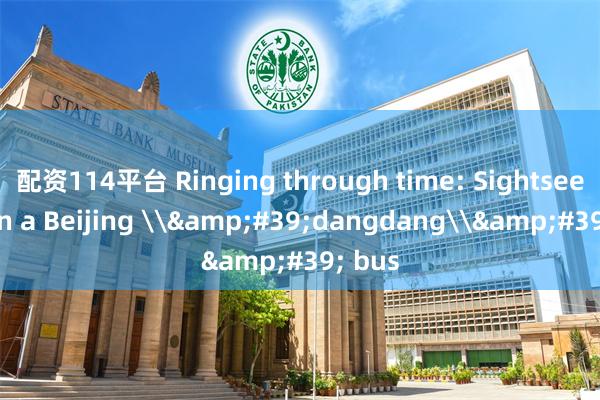配资114平台 Ringing through time: Sightseeing on a Beijing \'dangdang\' bus

肠道菌群由细菌、真菌、病毒等多种微生物组成,它们与人体之间形成了共生关系,共同维护着肠道微生态的平衡。这些微生物通过发酵未被小肠完全吸收的食物残渣配资114平台,产生短链脂肪酸等有益物质,为肠道细胞提供能量,促进肠道黏膜的修复与更新。同时,肠道菌群还参与调节免疫系统的功能,对抗病原体入侵,维护机体的整体健康。
A century ago, Beijing's first tram service started operation with copper bells that produced clear and crisp rings to signal its arrival and caution pedestrians of its approach. This distinctive "dang" sound become familiar to local residents and eventually earned the tram service's vehicles the affectionate name of "dangdang" buses. Today, "dangdang" buses can be seen around the capital's tourist hot spots and still resembling these early trams.
On Oct. 15, journalists from various media outlets hopped on a few of these old-fashion buses for a cultural heritage excursion along Beijing's Central Axis. Starting at Qianmen Street, a popular commercial street located along the axis, the excursion was part of "High-Quality Development Research Trip" interview activities and visited 15 cultural heritage sites. From the moment they stepped onto the buses, participants were fully immersed in the capital's profound historical heritage.
A modern "dangdang" bus with a vintage appearance similar to the original "dangdang" buses in Beijing, China, Oct. 15, 2024. [Photo by Liao Jiaxin/China.org.cn]
Wang Yu, a talkative tour guide on this sightseeing activity, told countless stories about the historic and cultural scenic spots along the journey's route, included Zhengyangmen, Yongdingmen, the Temple of Heaven, Tiananmen Square, the Forbidden City, and Jingshan Park .
The vintage-style decorations inside a modern "dangdang" bus in Beijing, China, Oct. 15, 2024. [Photo by Liao Jiaxin/China.org.cn]
Sightseers on the bus all praised Wang's vivid and interesting explanations. "We not only admired the beautiful scenery along the central axis but also learned a lot of interesting historical stories," said Li Jiayue, a journalist for China News Service who participant in this interview activity.
The view of Tiananmen Square from a "dangdang" bus during its route along the capital's Central Axis in Beijing, China, Oct. 15, 2024. [Photo by Liao Jiaxin/China.org.cn]
Besides conveying historical information, Wang also enthusiastically shared that the Great Beijing Central Axis sightseeing bus tour not only attracts local Beijingers who want to reminisce about the old days but also domestic and foreign tourists who come to Beijing for its reputation.
Since its launch in August, the Great Beijing Central Axis sightseeing bus tour has seen an average of 4,000 passengers daily on their 41 "dangdang" buses, according to Yun Haibing, the director of the Beijing Tourism Distribution Center's market management department. Yun also said that during the recent National Day holiday demand for bus tickets surged, with approximately 98,000 tourists in total going on guided bus tours.
In addition to listening to explanations full of Beijing flavor, passengers also sampled some traditional culinary treats, such as Peking Duck, as well as got a taste of local intangible cultural heritage. Through lively allegro performances, participants enjoyed classic stories related to the Central Axis.
A China allegro performance on a "dangdang" bus as it travels along the Central Axis in Beijing, China, Oct. 15, 2024. [Photo by Liao Jiaxin/China.org.cn]
Considered the spine of Beijing's urban layout, the Central Axis was added to the World Heritage List on July 27, 2024. After receiving this honor, the already well-known scenic spots along the Central Axis saw a rise in their popularity. A month later, eight sightseeing bus routes, such as the Great Beijing Central Axis sightseeing bus tour, were launched, offering more options for tourists to experience Beijing's rich cultural heritage and boosting the city's sightseeing bus tourism.
Follow China.org.cn on Twitterand Facebookto join the conversation.
ChinaNews App Download配资114平台
busasbusesandAxis发布于:北京市声明:该文观点仅代表作者本人,搜狐号系信息发布平台,搜狐仅提供信息存储空间服务。